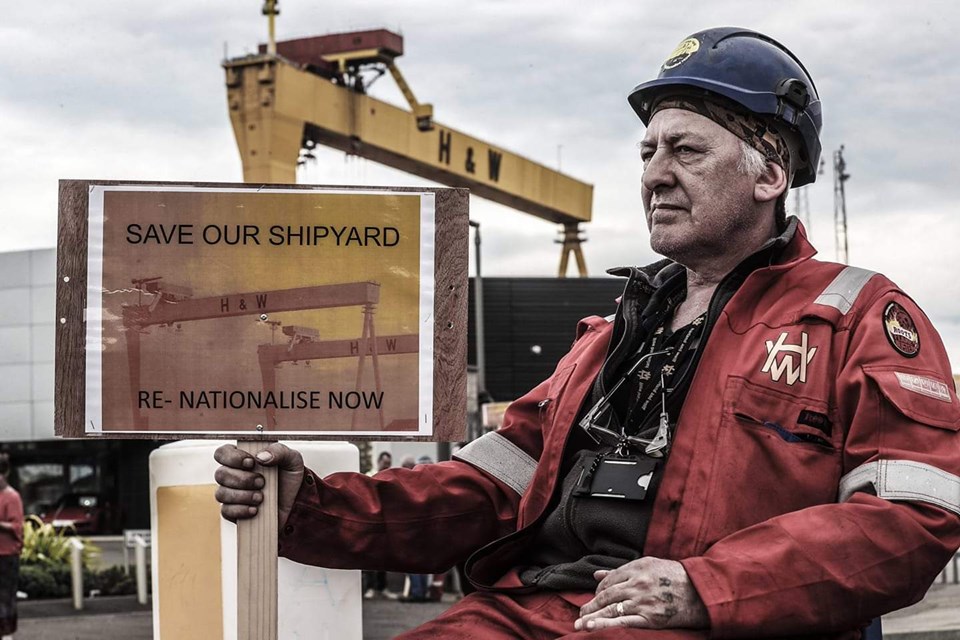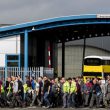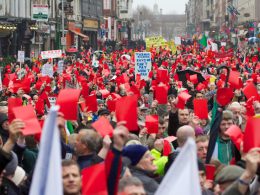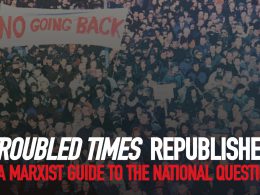For nine weeks, workers at Harland & Wolff in Belfast occupied the shipyard after the company went into administration, placing skilled jobs at risk. The workers at the shipyard – members of Unite and GMB trade unions – demanded that the government nationalise the yard to safeguard its future. Workers, young people and trade unionists have shown solidarity with this important struggle in order to defend this iconic landmark and create jobs for generations to come. The stand made by these workers is the reason the shipyard was saved, with a new buyer taking over the plant at the time of publishing.
Socialist Alternative spoke about this important workers’ struggle to one of the central leaders of the occupation, Unite’s Regional Coordinator and Socialist Party member Susan Fitzgerald.
The workers’ occupation at Harland & Wolff shipyard was truly historic. Can you explain how the dispute erupted?
Weeks before the dispute erupted, there was a buyer that was the exclusive focus of the administrators. This buyer had promised to take on the assets and the workforce of Harland & Wolff but then, at the eleventh hour, reduced their bid significantly and, most importantly, refused to take on the workforce. At this point, management had their head in their hands and it was left to the unions to pull together a plan which, aside from going to the workforce, initially focused on discussing with government, politicians and the administrator regarding what could be done to save the shipyard.
While these talks were going on, we had regular canteen meetings with all the workers and, as well as updating them on what was happening, we argued that it was clear that they would need to take action to put their stamp on events. We referenced and drew out the lessons of the workers’ occupations at the Ford/Visteon plant in Belfast ten years ago and at Waterford Crystal. We also talked about other occupations, including ones led by socialists like Jimmy Reid, who organised the “work-in” in the 1970s against attempts to lay off shipyard workers on the Clyde.
Importantly, we talked about what was necessary to save the yard – re-nationalisation. The workers were well aware that the shipyard had been previously nationalised from 1977 to 1989. The case for nationalisation wasn’t made in some “ideological” way but flowed from the reality that there was no easy private-sector fix. Yet, we had this resource that could be used to invest in green energy, an area of work that the yard had been engaged in for the previous 10-15 years.
While talks were ongoing, behind the scenes, plans were being drawn up to occupy the yard should this be required. A workplace “Cobra Committee” was established, along the lines of the British Government’s emergency committee. By 29th July, it was clear that there were no last-minute rescue plans and it was necessary for the workers to declare that they were taking over the shipyard. At the same time, you had similar event at Ferguson Marine in Glasgow, where the Scottish government announced it would nationalise the shipyard. This strengthened the case for nationalisation – if they could do it Scotland, why couldn’t they do it here?
So the main banner that hung from the famous Samson crane was “Save Our Shipyard: Re-Nationalise Now!”
There was massive support for the stand taken by the shipyard workers. Can you talk about the solidarity that was shown?
After that banner went up and the occupation began, solidarity appeared in spades from every type of worker you can think of. The Bombardier workers, who are based next door to the shipyard, were among the first to turn out. As soon as the occupation began, they got a banner made saying “Bombardier workers stand in solidarity with Harland & Wolff workers.” In a scene reminiscent of the past, when they marched together for better pay, Bombardier workers made their way up the airport road and were greeted with loud cheers and clapping. It was genuinely emotional.
Many agency workers who, in the recent past, worked in the shipyard showed up and stood at the occupation daily to offer their support, seeing the struggle for what it was: a fight for decent jobs. When the Ferguson Marine shipyard was nationalised, the workers there said Harland & Wolff was next and produced a banner in solidarity, sending a senior union convenor over to Belfast to bring greetings.
Even before the occupation had begun, when civil servants were on strike, they got pictures taken holding placards in solidarity with the shipyard. We had people from across Northern Ireland showing up: footballers, musicians, comedians, writers, pipe bands – you name it. When the Irish Congress of Trade Unions organised a rally, each union left behind their flag as a message that this was a fight for the whole movement and to show unity.
Solidarity also came in from across the island of Ireland, with workers in the South coming to visit the occupation. Unite construction and energy workers visited, bringing thousands of euros with them for the hardship fund. The Unite construction branch t-shirts were seen everywhere at the yard. Waterford Crystal workers travelled up to speak and to share their occupation experience, and again came with a fantastic donation.
As much as the workers got solidarity, they were prepared to give it back. On the week of Belfast Pride, the workers put up two pride flags which are still flying to this day, hoisted at the gate. During various Pride demonstrations, “Save Our Shipyard” flags and t-shirts were carried along in support of the shipyard workers. Many people also took the placards of the Socialist Party, which said “Pride Means Solidarity: Support the Shipyard Workers.” On the day of the Earth Strike, workers postered the site with signs supporting the strike, wore Earth Strike t-shirts and helped carry union banners on the march.
Similarly, when Boris Johnson came to Stormont, the shipyard workers were the first people out protesting. Obviously, they were joined by others on the day, protesting for different causes, including Irish language activists. At a certain point, the shipyard workers discussed with the Irish language group and asked them how to say “Save our shipyard” in Irish. We then proceeded to chant this together. This was done as a gesture by the shipyard workers, led by Unite representative Joe Passmore, to reach out and show respect to all communities in Northern Ireland and is illustrative of the potential that exists when workers struggle together to actually deal with the issues deemed to be contentious on the basis of mutual respect and solidarity.
On that point, the media and others have injected the history of sectarianism into the dispute. How did you respond to this?
Workers were very angry when the BBC showed old footage of a Catholic worker from 40 years ago being interviewed about sectarian intimidation in the workplace; not because anyone should engage in a whitewash of the past, but because it was a lazy and crude depiction of the shipyard, particularly as it exists today. It was particularly seen as crude in the context of a united struggle to defend jobs.
It was also a one-sided presentation of what happened in the shipyards. I challenged the BBC business editor to cover the story of the senior shop steward Sandy Scott who, fifty years ago last month, when the Troubles began, organised a mass meeting of the workforce because Catholic workers had not come to work for fear of sectarian attack. At the meeting, shipyard workers unanimously passed a motion organising a token strike against sectarianism and the shop stewards then visited the homes of Catholic shipyard workers, successfully appealing to them to return. At the same time, Ian Paisley was only able to mobilise 180 out of a workforce of 8,000 to support his rallies. There was much discussion at the yard as to why we never hear these stories. So far, it doesn’t look like the BBC have taken up our suggestion, but we made contact with Sandy Scott to tell him about the occupation and to praise his role.
As you have already said, the workers demanded nationalisation of the shipyard. As a socialist, what do you mean by nationalisation?
The demand that the government should nationalise the shipyard makes perfect “common sense”, particularly in the context of the need to deal with the environmental crisis and to create green jobs.
No one has a better understanding of what is needed to run the shipyard, or expertise in terms of what is needed, than the workers. No one has more invested in a real sense in the shipyard than the workers themselves and no one has demonstrated a greater willingness to fight for the shipyard than the workers themselves. So, in my view, it makes perfect sense that not only should the shipyard be taken into public ownership but that it would be handed over to the real experts to run – the workers. In other words, that there should be workers’ control and management of the shipyard. This would mean the workers could take decisions, not simply on the basis of the profit motive, but on the basis of what is socially useful and in the interests of our environment – like green energy.
The new buyer coming in represents an important victory, in that it secures the shipyards and skilled jobs for now. It was only possible because of the struggle waged, which ensured that workers were temporarily laid-off as opposed to being made redundant, and ensured the issue of the shipyard was kept on the agenda. Nonetheless, nationalisation would have been and remains the best way to secure the shipyard for the long-term and to ensure the workers’ skills are put to the best use for society as a whole. It speaks volumes about the politics of the main local parties and the Tories that this was never seriously considered.
I was far from the only socialist at the yard and one of the things you saw really graphically was the ability of workers to rapidly learn far-reaching lessons from the struggle that they were involved in. At the same time, you had a workforce with lots of different political and religious views, including with strong convictions. Yet workers showed an ability to discuss these issues in a respectful manner, albeit with the usual and signature slagging.
One view that became clearer, though, is that neither Unionist nor nationalist politicians represent the interests of working-class people. I think it was understood that, when you are in a battle like this, the only people you can really rely on are other workers and your own organisations. As a socialist, I think there is a bigger need than ever for the trade union movement to put its own agenda on the table and look at how they can challenge the main parties in a manner that can unite working-class people.
Obviously, we are seeing important movements of young people developing, including school strikes against climate change. How is this workers’ struggle relevant to those movements?
Nobody understands as well as Harland & Wolff workers the role that the shipyard can play in terms of creating green energy. For the last 10 to 15 years, these workers have been involved in making prototypes and building the physical infrastructure that is necessary for at-sea wind turbines. As a union, we have been constantly arguing for years for Harland & Wolff to become a specialist in green energy. Before the recent crisis, the reps and I took it upon ourselves to research and identify possible work in this sector. We used the Socialist Party position in the Dáil to get questions asked about upcoming projects that could bring work. We pushed via Unite’s presence in Westminster. But, in hindsight, its clear the management had no real interest and had given up.
Environmentalists will know InfaStrata, the company that has taken over the shipyard, for its role in exploratory drilling for oil at Woodburn Forest near Carrickfergus and the current controversial gas storage project at Islandmagee. Socialist Party members and many trade union activists have been involved in these campaigns. There’s no doubt that many of the workers would want their skills used to help deal with the environmental catastrophe and the union will keep campaigning for green jobs along with a just transition. The central problem, however, is that you cannot control what you don’t own. Left in private hands, the shipyard will be used for whatever is most profitable whether that is renewable energy or fossil fuels. The only way to ensure the shipyard is used in an environmentally sustainable way is on the basis of public ownership and democratic workers’ control.
The workers, of course, also know that many of the young people visiting them at the site have been young socialists and environmental activists. All the workers saw the struggle they were involved in as not just being about defending their jobs, but in holding the line in terms of a struggle for a decent future for young people. Saving the shipyard gives the opportunity to pass on the skills that exist in the shipyard to a younger generation by bringing on apprentices, something that is key if we are to use the shipyard for green jobs.
Are we beginning to see an upturn in workers’ struggles in Northern Ireland? We have had strike action by civil servants, as well as other workers – from postal workers to nurses – balloting for action. We have also seen a new threat to 1,200 manufacturing jobs at Wrightbus. What lessons do you think there are for workers generally from this dispute?
Before this dispute, the shipyard and the idea of shipbuilding in Belfast was written of as a relic of the past. It was the workers themselves who had confidence that there was a future for the industry and could see how their skills could be put to use.
The occupation showed the capacity of workers to organise and rise to the challenge. Every day of the occupation, I witnessed ingenuity and huge ability to deal with problems, big or small. These workers have developed into class warriors to meet the needs of the struggle – organising finance, managing rotas, developing structures and, most importantly, a plan to win. They have shown they can articulately argue their case, both in the media and meetings, while taking care of each other over those long weeks. It’s endlessly impressive to me to see the sharpness of thought in meetings and in private, matched with a razor-like ability to see behind business bullshit.
The other lesson we touched on earlier is that when a group of workers take a stand, they will be met with solidarity from thousands of workers from all backgrounds. We were particularly taken aback by the solidarity from trade unionists and workers in South Africa who found out about the dispute via the Socialist Party’s sister organisation, the Workers and Socialist Party. The idea that these hard-pressed workers were inspired and took action in solidarity with workers in Belfast was simply incredible and a point of conversation repeatedly.
Wrightbus is another graphic illustration of the complete disregard the capitalist system has for workers, its willingness to throw skilled workers who have given years of their life to an enterprise on the scrapheap. The lesson from Harland & Wolff is that struggle and class solidarity is key to defending jobs. As we speak, the workers at the yard are hiring buses to join Wrightbus workers in Ballymena in a rally to save their jobs.
As the militant trade union leader Bob Crow used to say, “If you fight you might win, if you don’t, you’ve already lost.” There are no guarantees of victory but the struggle of these workers has been central to securing their jobs and a future for the yard. The last thing I would say is that the struggle of these workers shows that a socialist alternative to the failures of capitalism is possible and the key agent to deliver that is the working class.












